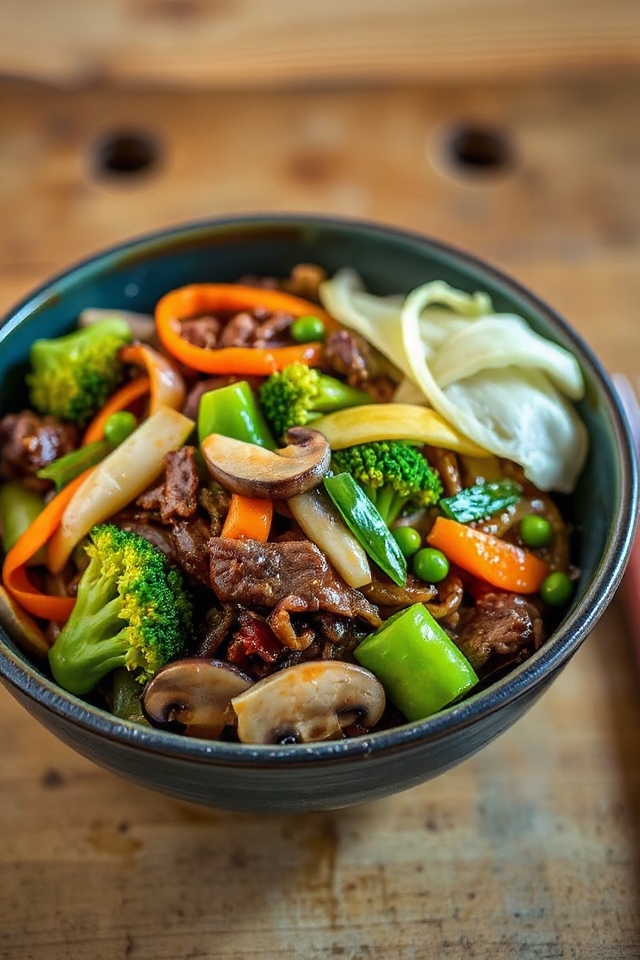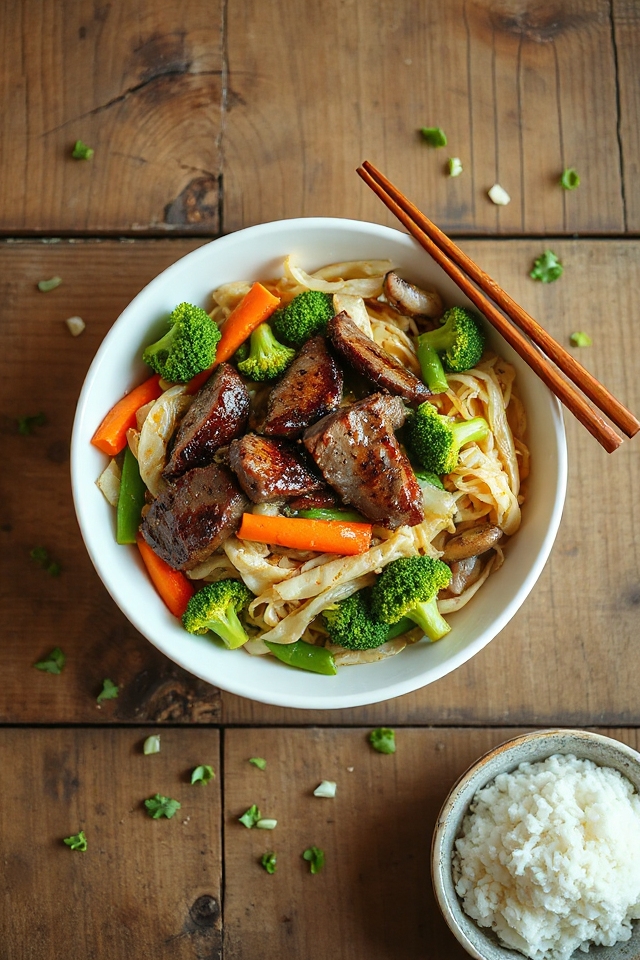Why You’ll Love this Beef Chow Mein Recipe
If you’re looking for a quick and satisfying meal, you’re going to love this Beef Chow Mein recipe. It’s packed with vibrant vegetables, tender beef, and a savory sauce that ties everything together perfectly.
The best part? It all comes together in under 30 minutes, making it ideal for those busy weeknights. I appreciate how customizable it is, too; you can easily swap in your favorite veggies or adjust the seasoning to suit your taste.
Plus, serving it over hot rice adds that comforting touch. Trust me, once you try it, this dish will become a go-to favorite!
Ingredients of Beef Chow Mein
When it comes to whipping up a delicious meal that satisfies both the belly and the soul, Beef Chow Mein is a winner. With its colorful mix of veggies and tender beef, it’s not just a feast for your taste buds but also for your eyes. I mean, who doesn’t love a dish that looks as good as it tastes?
The best part? You probably already have most of these ingredients in your kitchen. So let’s get down to business and gather what we need to create this tasty dish.
Ingredients for Beef Chow Mein:
- 2 ounces beef sirloin or rump roast, trimmed and sliced thin
- 1 dash salt
- 1 dash pepper
- 1/2 teaspoon minced garlic
- 2 1/2 teaspoons sugar
- 1 teaspoon sesame oil
- 1/4 teaspoon black pepper
- 1 teaspoon chopped garlic
- 4 teaspoons fish sauce or soy sauce
- 1 cup broccoli florets
- 1/4 cup thinly sliced carrot
- 2 small mushrooms, thinly sliced
- 1/4 cup thinly sliced bamboo shoot
- 4-5 snow peas, sliced
- 1/4 cup sliced celery
- 1/2 cup thinly sliced onion
- 1 cup napa cabbage
- 2-3 teaspoons oyster sauce
- 2 cups hot cooked rice
Now, before you start gathering these ingredients, let’s chat a bit about substitutions and considerations. If you’re not a fan of beef, you can easily swap it out for chicken or tofu.
Seriously, the world is your oyster—well, not literally if you’re using oyster sauce, but you get the point. And speaking of sauces, if you’re keeping it light on sodium, you might want to opt for low-sodium soy sauce.
The veggies can also be adjusted based on what’s in season or what’s lurking in the back of your fridge—just about anything goes. So feel free to get creative and make this dish your own. Happy cooking!
How to Make Beef Chow Mein

Alright, let’s plunge into the delightful world of making Beef Chow Mein. First things first, grab your 2 ounces of beef sirloin (or rump roast if that’s what you’ve got in your fridge). Trim off any fat and slice it thinly—this is key because nobody wants chewy beef in their chow mein, right?
Season the beef with a dash of salt, a dash of pepper, and 1/2 teaspoon of minced garlic, then pop it into the refrigerator for about two hours. This little marinating step is like giving your beef a spa day; it helps to infuse those flavors and tenderize the meat.
Now, while the beef is chilling out, let’s prepare the flavorful sauce. In a small bowl, mix together 2 1/2 teaspoons sugar, 1 teaspoon sesame oil, 1/4 teaspoon black pepper, and 4 teaspoons of either fish sauce or soy sauce. Set this aside because, trust me, it’s going to bring everything together later.
Once the two hours are up and your beef is ready, heat a skillet or wok over high heat. Stir-fry the beef until it’s cooked through—that should take just a few minutes.
Next, it’s time to add in the excitement: toss in 1 cup of broccoli florets, 1/4 cup thinly sliced carrot, 2 small mushrooms (sliced, of course), 1/4 cup bamboo shoots, a handful of snow peas, 1/4 cup sliced celery, and 1/2 cup thinly sliced onion.
Stir and shake that pan like you mean it for about 2-3 minutes. You want those veggies to become aromatic but still crisp—nobody wants mushy vegetables in their chow mein.
After they’ve reached that perfect state, stir in your sauce mixture along with 1 cup of napa cabbage and 2-3 teaspoons of oyster sauce. Keep stir-frying for about a minute until everything is beautifully mixed and the vegetables are just tender.
Voilà! Serve this colorful, fragrant goodness over 2 cups of hot cooked rice, and there you have it—a bowl of Beef Chow Mein that’s sure to impress. Enjoy your culinary creation, and remember, if it doesn’t turn out perfect, just say it’s a new “rustic” dish.
Beef Chow Mein Substitutions & Variations
Exploring Beef Chow Mein allows for plenty of creativity, as there are numerous substitutions and variations to suit your tastes or dietary needs.
For a lighter dish, I often swap beef for chicken or tofu. If you’re avoiding gluten, tamari works great instead of soy sauce. You can mix in different veggies like bell peppers or spinach, depending on what’s in my fridge.
I sometimes add ginger for an extra kick or switch out oyster sauce for hoisin. Don’t hesitate to personalize the flavors until it’s perfect for you—experimenting is part of the fun!
Enjoy your culinary adventure!
What to Serve with Beef Chow Mein
To enhance your Beef Chow Mein experience, consider serving it alongside a rejuvenating cucumber salad or steamed dumplings.
The crispness of the salad perfectly complements the savory flavors of the chow mein, adding a revitalizing crunch.
Dumplings, whether steamed or pan-fried, create a delightful textural contrast and can be filled with a variety of flavors, allowing for a fun pairing.
For a complete meal, I also like to include a warm bowl of hot and sour soup; it adds a spicy kick that balances the richness of the beef.
Enjoying these sides can elevate your dining experience considerably!
Additional Tips & Notes
While cooking Beef Chow Mein, I’ve found a few tips that can really enhance the dish. First, marinating the beef for a couple of hours adds depth to the flavor.
I also recommend using a hot wok to achieve that perfect stir-fry texture. Be sure to prep all your ingredients beforehand, as things move quickly.
For an extra kick, toss in some red pepper flakes or fresh ginger.
Finally, don’t overcrowd the pan; cooking in batches can help maintain that crispness in your veggies.
Trust me, these small adjustments make a big difference in your Beef Chow Mein!
